
Wake Island is a coral atoll in the Micronesia subregion of the northwestern Pacific Ocean. The atoll is composed of three islets and a reef surrounding a lagoon. The nearest inhabited island is Utirik Atoll in the Marshall Islands, located 592 miles to the southeast. The United States administers Wake Island as an unorganized and unincorporated territory, and it is one of the nine insular areas that comprise the United States Minor Outlying Islands. The Marshall Islands also claim Wake Island.

USS New Orleans (CL/CA-32) was the lead New Orleans-class cruiser in service with the United States Navy. The New Orleans-class cruisers were the last U.S. cruisers built to the specifications and standards of the Washington Naval Treaty of 1922. Such ships, with a limit of 10,000 long tons (10,160 t) standard displacement and 8-inch (203-millimetre) calibre main guns may be referred to as "treaty cruisers." Originally classified a light cruiser, because of her thin armor, she was reclassified, soon after being laid down, a heavy cruiser, because of her 8-inch guns. The term "heavy cruiser" was not defined until the London Naval Treaty in 1930.

USS Nautilus (SF-9/SS-168), a Narwhal-class submarine and one of the "V-boats", was the third ship of the United States Navy to bear the name.
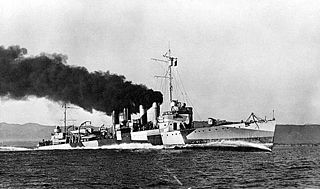
USS Ward was laid down as a 1,247-long-ton (1,267 t) Wickes-class destroyer in the United States Navy during World War I, later converted to a high speed transport in World War II. She was responsible for the first American-caused casualties in the Pacific in World War II when she engaged and sank a Japanese midget submarine before Japanese aircraft arrived in the attack on Pearl Harbor, killing both crewmen on board.

USS Tuna (SS-203) was a United States Navy Tambor-class submarine, serving in the Pacific during World War II and earning seven battle stars for her service. After the war, she participated in the Bikini Atoll atomic testing in 1946.

Mahan-class destroyers of the United States Navy were a series of 18 destroyers of which the first 16 were laid down in 1934. The last two of the 18, Dunlap and Fanning, are sometimes considered a separate ship class. All 18 were commissioned in 1936 and 1937. Mahan was the lead ship, named for Rear Admiral Alfred Thayer Mahan, an influential historian and theorist on sea power.

The Battle of Makin was an engagement of the Pacific campaign of World War II, fought from 20 to 24 November 1943 on Makin Atoll in the Gilbert Islands.
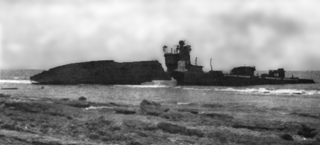
The Battle of Wake Island was a battle of the Pacific campaign of World War II, fought on Wake Island. The assault began simultaneously with the attack on Pearl Harbor naval and air bases in Hawaii on the morning of 8 December 1941, and ended on 23 December, with the surrender of American forces to the Empire of Japan. It was fought on and around the atoll formed by Wake Island and its minor islets of Peale and Wilkes Islands by the air, land, and naval forces of the Japanese Empire against those of the United States, with Marines playing a prominent role on both sides.
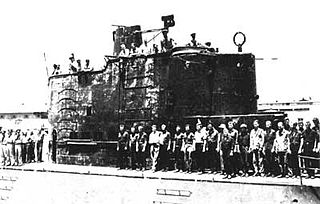
The Raid on Makin Island was an attack by the United States Marine Corps Raiders on Japanese military forces on Makin Island in the Pacific Ocean. The aim was to destroy Imperial Japanese installations, take prisoners, gain intelligence on the Gilbert Islands area, and divert Japanese attention and reinforcements from the Allied landings on Guadalcanal and Tulagi. Only the first of these objectives were achieved, but the raid did boost morale and provide a test for Raider tactics.

Johnston Island Air Force Base is a former United States Air Force base on the Johnston Atoll in the United States Minor Outlying Islands, in the Pacific Ocean several hundred kilometers southwest of Hawaii. After its closure, it briefly operated as Johnston Atoll Airport, until that also closed in 2005.

The Battle of Guam was an engagement during the Pacific War in World War II, and took place from 8 December to 10 December 1941 on Guam in the Mariana Islands between Japan and the United States. The American garrison was defeated by Japanese forces on 10 December, which resulted in an occupation until the Second Battle of Guam in 1944.

USS William Ward Burrows was a transport ship that saw service with the United States Navy in World War II. The ship was the former Grace Steamship Company liner MV Santa Rita by Burmeister & Wain and launched in 1929 at Copenhagen, Denmark.

The First Bombardment of Midway, or the First Bombardment of Sand Island, or Attack on Midway, was a small land and sea engagement of World War II. It occurred on the very first day of the Pacific War, 7 December 1941, not long after the major attack on Pearl Harbor. Two Imperial Japanese destroyers bombarded Sand Island of Midway Atoll. The Japanese successfully damaged the U.S. Marine base before being engaged by American shore batteries and forced to flee.
I-73 was an Imperial Japanese Navy Kaidai type cruiser submarine of the KD6A sub-class commissioned in 1937 that served during World War II. One month after participating in the Japanese attack on Pearl Harbor, she was sunk by the United States Navy submarine USS Gudgeon (SS-211) in January 1942.

I-75, later I-175, was an Imperial Japanese Navy Kaidai-type cruiser submarine of the KD6B sub-class commissioned in 1938. During World War II, she took part in the attack on Pearl Harbor, the Battle of Midway, the Guadalcanal campaign, the Aleutian Islands campaign, and the Gilbert and Marshall Islands campaign and operated off Australia, before she was sunk in 1944 during her tenth war patrol. She is best known for sinking the United States Navy escort carrier USS Liscome Bay on 24 November 1943.

1st Light Antiaircraft Missile Battalion was a United States Marine Corps air defense unit equipped with the medium range surface-to-air MIM-23 HAWK Missile System. The battalion was the lineal descendant of the 1st Defense Battalion which gained fame during World War II for its defense of Wake Island early in the war. 1st LAAM also deployed to Vietnam in 1965 providing air defense for the Marine Corps in the I Corps sector. The battalion was last based at Marine Corps Air Station Yuma, Arizona and fell under the command of Marine Air Control Group 38 (MACG-38) and the 3rd Marine Aircraft Wing.
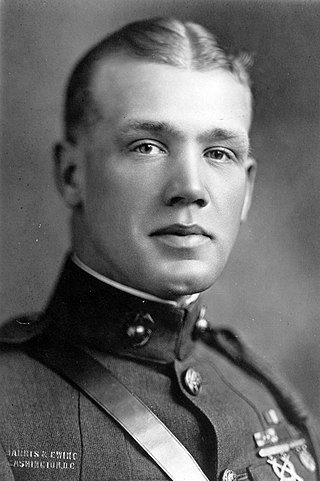
Harold Cyrus Roberts was a highly decorated officer in the United States Marine Corps with the rank of colonel. He was the recipient of three Navy Crosses, the United States military's second-highest decoration awarded for valor in combat.
I-69, later I-169, was an Imperial Japanese Navy Kaidai-class cruiser submarine of the KD6 sub-class commissioned in 1935. She served in World War II, during which she conducted six war patrols and took part in operations supporting the attack on Pearl Harbor, the Battle of Midway, the Guadalcanal campaign, the Aleutians campaign, and the defense of the Gilbert Islands. She sank in a diving accident in April 1944.

Naval Base Hawaii was a number of United States Navy bases in the Territory of Hawaii during World War II. At the start of the war, much of the Hawaiian Islands was converted from tourism to a United States Armed Forces base. With the loss of US Naval Base Philippines in Philippines campaign of 1941 and 1942, Hawaii became the US Navy's main base for the early part of the island-hopping Pacific War against Empire of Japan. Naval Station Pearl Harbor was founded in 1899 with the annexation of Hawaii.
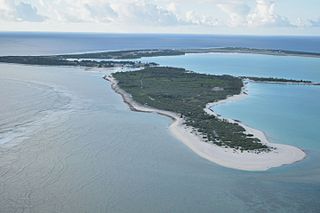
Peale Island is one of three islands in the Wake Island atoll, which lies in the Pacific Ocean between Guam and Midway. The atoll was from 1935 the site of a seaplane base and a hotel built by Pan-American, who started the first transpacific passenger service using a string of islands across the Pacific to fly between America and Asia in stages. The island, like the rest of Wake, is made of coral fragments and sand, atop a seamount, and ringed by a living coral reef. The island is heavily forested with tropical scrub, trees, and grasses and is inhabited mainly by birds, rats, and hermit crabs. In the late 20th century, it was the site of a United States Coast Guard Loran Station, supporting radio navigation prior to satellite systems. The island is home to many historical items, including the Pan-American Hotel and remnants of World War II, such as bunkers and a rusted 8-inch coastal defense gun.




















